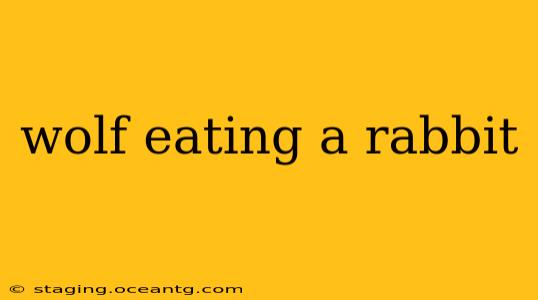The image of a wolf devouring a rabbit is a powerful snapshot of nature's raw beauty and brutal efficiency. It's a scene that evokes a range of emotions, from awe and fascination to a sense of primal power and the stark reality of the food chain. This seemingly simple interaction is rife with ecological significance and fascinating behavioral nuances. Let's delve into the details of this captivating encounter.
What are the Stages of a Wolf's Hunt for a Rabbit?
A wolf's hunt for a rabbit is a testament to its incredible hunting prowess, even when the prey is significantly smaller. It starts with detection, often relying on keen senses of smell and hearing to pinpoint the rabbit's location. Next comes the stalk, a slow, deliberate approach to get within striking distance, often utilizing cover for camouflage. The chase can be short and swift, depending on the rabbit's escape route and the wolf's proximity. Finally, the kill involves a quick bite to the neck, swiftly ending the rabbit's life.
How Often Do Wolves Eat Rabbits?
While rabbits aren't a primary food source for wolves, they form a significant part of their diet, particularly when other prey like deer or elk are scarce. The frequency of a wolf eating a rabbit varies depending on several factors, including the availability of other prey, the wolf pack's size and territory, and the rabbit population density within their hunting grounds. Rabbits provide a valuable source of calories and nutrients, especially for younger wolves or during lean times.
What Other Animals Prey on Rabbits?
Rabbits face a multitude of predators in various ecosystems. Beyond wolves, coyotes, foxes, bobcats, ferrets, weasels, hawks, owls, and even snakes are all known to prey upon rabbits. This diverse range of predators highlights the rabbit's crucial role in maintaining the ecological balance of its habitat. The constant threat of predation drives the evolution of swift reflexes and camouflage in rabbits, ensuring the continuation of their species.
Do Wolves Hunt Rabbits in Packs?
While wolves are known for their pack hunting strategies when targeting larger prey, they can also hunt rabbits individually. Pack hunting for rabbits is less common, as the energy expenditure involved in coordinating a pack hunt for such small prey might outweigh the benefits. However, a lone wolf might still take advantage of a situation where several rabbits are present in close proximity.
Why is Seeing a Wolf Eating a Rabbit Important?
Observing a wolf eating a rabbit provides a glimpse into the complex dynamics of a natural ecosystem. It showcases the predator-prey relationship, demonstrating the interconnectedness of all living things. Furthermore, studying such interactions helps scientists and conservationists understand population dynamics, habitat requirements, and the overall health of the ecosystem. This knowledge is crucial for developing effective conservation strategies to protect both predators and their prey.
In conclusion, the image of a wolf eating a rabbit is more than just a fleeting moment in nature; it's a powerful representation of the intricate web of life. Understanding the ecological context surrounding this interaction is key to appreciating the beauty and complexity of the natural world.
